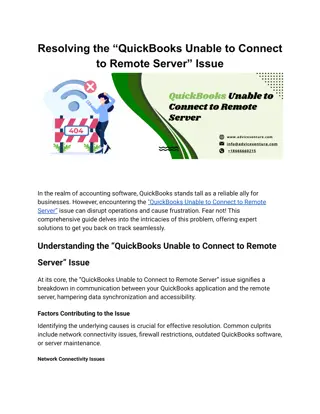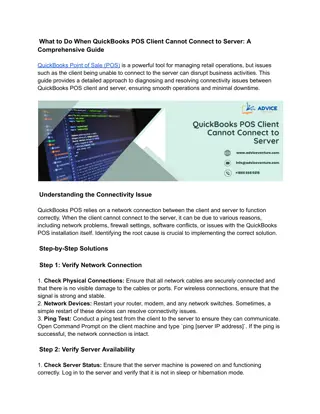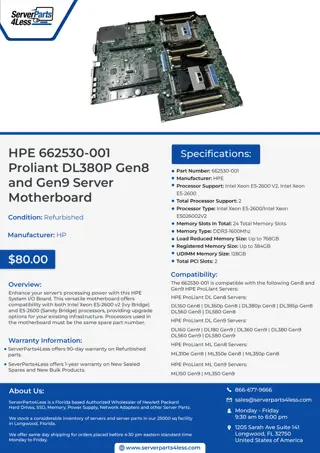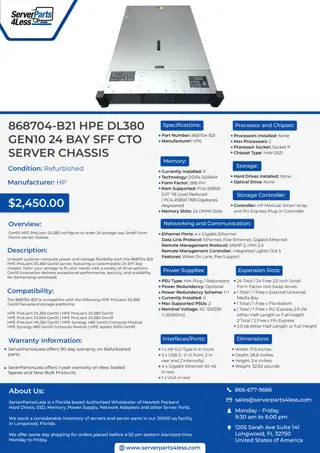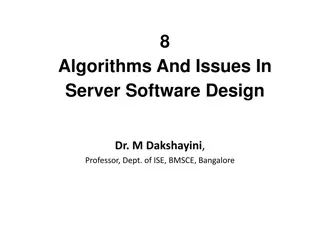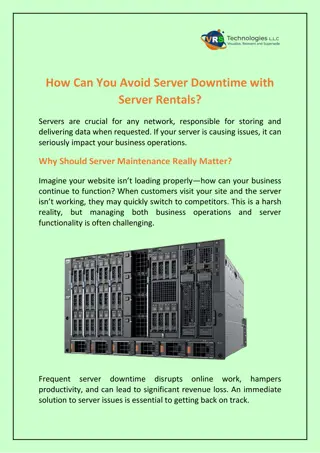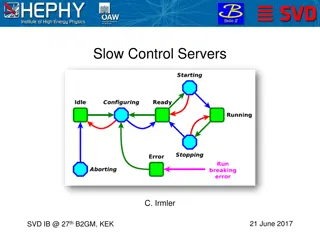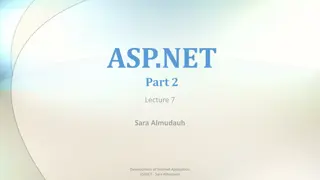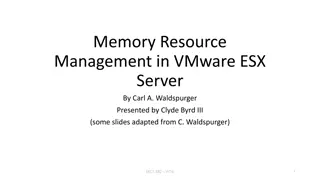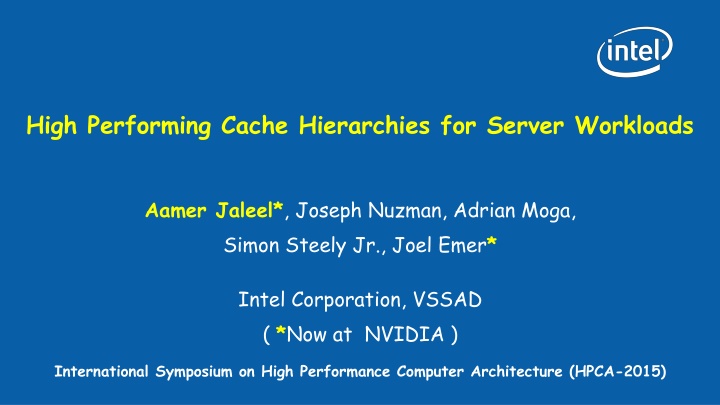
Efficient Cache Hierarchy Optimization for Server Workloads
Explore the significance of high-performing cache hierarchies in server workloads, addressing issues related to CPU and memory speeds, cache hits, and latency. Learn about performance characterization, inefficiencies in existing cache hierarchies, and optimization strategies for improved efficiency.
Download Presentation

Please find below an Image/Link to download the presentation.
The content on the website is provided AS IS for your information and personal use only. It may not be sold, licensed, or shared on other websites without obtaining consent from the author. If you encounter any issues during the download, it is possible that the publisher has removed the file from their server.
You are allowed to download the files provided on this website for personal or commercial use, subject to the condition that they are used lawfully. All files are the property of their respective owners.
The content on the website is provided AS IS for your information and personal use only. It may not be sold, licensed, or shared on other websites without obtaining consent from the author.
E N D
Presentation Transcript
High Performing Cache Hierarchies for Server Workloads Aamer Jaleel*, Joseph Nuzman, Adrian Moga, Simon Steely Jr., Joel Emer* Intel Corporation, VSSAD ( *Now at NVIDIA ) International Symposium on High Performance Computer Architecture (HPCA-2015)
Motivation Factors making caching important CPU speed >> Memory speed Chip Multi-Processors (CMPs) iL1 dL1 iL1 dL1 iL1 dL1 L2 L2 L2 Variety of Workload Segments: Multimedia, games, workstation, commercial server, HPC, LLC Bank LLC Bank LLC Bank High Performing Cache Hierarchy: Reduce main memory accesses ( e.g. RRIP replacement policy ) Service on-chip cache hits with low latency 2
LLC Hits SLOW in Conventional CMPs Typical Xeon Hierarchy CORE 0 CORE 1 CORE 2 CORE3 CORE n + 3 cycs 32KB L1 32KB L1 32KB L1 32KB L1 32KB L1 256KB L2 256KB L2 256KB L2 256KB L2 256KB L2 + 10 cycs + 10 cycs INTERCONNECT 2MB L3 slice 2MB L3 slice 2MB L3 slice 2MB L3 slice 2MB L3 slice + 14 cycs Large on-chip shared LLC more application working-set resides on-chip LLC access latency increases due to interconnect LLC hits become slow L2 Hit Latency: ~15 cycles LLC Hit Latency: ~40 cycles 3
Performance Characterization of Workloads Prefetching OFF Prefetching ON 100% 100% 90% 90% 10-30% 15-40% 80% 80% Total Execution Time Total Execution Time 70% 70% 60% 60% Memory Memory 50% 50% L3-cache L3-cache L2-cache L2-cache 40% 40% compute compute 30% 30% 20% 20% 10% 10% 0% 0% SPEC CPU2006 SERVER SPEC CPU2006 SERVER Single-Thread Simulated on 16-core CMP Server Workloads Spend Significant Execution Time Waiting on L3 Cache Access Latency 4
Performance Inefficiencies in Existing Cache Hierarchy Problem:L2 cache ineffective when the frequently referenced application working set is larger than L2 (but fits in LLC) Solution:Increase L2 Cache Size iL1 dL1 iL1 dL1 iL1 iL1 dL1 dL1 L2 L2 L2 L2 LLC LLC LLC LLC LLC Must also increase LLC size for an inclusive cache hierarchy Redistribute cache resources Requires reorganizing hierarchy 5
Cache Organization Studies iL1 dL1 iL1 dL1 iL1 dL1 OR 256KB L2 512KB L2 1MB L2 2MB LLC 1.5 MB LLC 1MB LLC (Inclusive LLC) (Exclusive LLC) (Exclusive LLC) Increase L2 cache size while reducing LLC Design exclusive cache hierarchy Exclusive hierarchy helps retain existing on-chip caching capacity ( i.e. 2MB / core ) Exclusive hierarchy enables better average cache access latency Access latency overhead for larger L2 cache is minimal (+0 for 512KB, +1 cycle for 1MB) 6
Performance Sensitivity to L2 Cache Size 1.06 512KB L2 /1.5MB L3 (Exclusive) 1MB L2 /1MB L3 (Exclusive) Performance Relative to Baseline 1.04 1.02 1.00 dh games multimedia office productivity server SPEC CPU2006 workstation ALL Server Workloads Observe the MOST Benefit from Increasing L2 Cache Size 7
Server Workload Performance Sensitivity to L2 Cache Size 1.14 512KB L2 /1.5MB L3 (Exclusive) 1MB L2 /1MB L3 (Exclusive) Performance Relative to Baseline 1.12 1.10 1.08 1.06 1.04 1.02 1.00 mgs tpch gidx ibuy ncpr ncps sap sas sjap sjbb sweb tpcc ALL A Number of Server Workloads Observe > 5% benefit from larger L2 caches Where Is This Performance Coming From???? 8
Understanding Reasons for Performance Upside Larger L2 Two types of requests: Code Requests and Data Requests Which requests serviced at L2 latency provide bulk of performance? Lower L2 miss rate More requests serviced at L2 hit latency Sensitivity Study: In baseline inclusive hierarchy (256KB L2), evaluate: i-Ideal: L3 code hits always serviced at L2 hit latency d-Ideal: L3 data hits always serviced at L2 hit latency id-Ideal: L3 code and data hits always serviced at L2 hit latency NOTE: This is NOT a perfect L2 study. 9
Code/Data Request Sensitivity to Latency 256KB L2 /2MB L3 (Inclusive) 1.20 i-Ideal d-Ideal id-Ideal 1MB L2 / 1MB L3 (Exclusive) sensitive to data Performance Relative to Baseline sensitive to code 1.15 1.10 1.05 1.00 mgs tpch gidx ibuy ncpr ncps sap sas sjap sjbb sweb tpcc ALL Performance of Larger L2 Primarily From Servicing Code Requests at L2 Hit Latency (Shouldn t Be Surprising Server Workloads Generally Have Large Code Footprints) 10
SERVER MPKI MPKI LARGE CODE WORKING SET Cache Size (MB) Cache Size (MB) MPKI MPKI (0.5MB 1MB) Cache Size (MB) Cache Size (MB) 11
Enhancing L2 Cache Performance for Server Workloads Observation: Server workloads require servicing code requests at low latency Avoid processor front-end from frequent hiccups to feed the processor back-end How about prioritize code lines in the L2 cache using the RRIP replacement policy Proposal: Code Line Preservation (CLIP) in L2 Caches Modify L2 cache replacement policy to preserve more code lines over data lines inserts code inserts data inserts eviction 0 1 2 3 No Victim No Victim No Victim Imme- diate Inter- mediate far distant re-reference data re-reference data re-reference data re-reference re-reference re-reference 12
Performance of Code Line Preservation (CLIP) 1.20 256KB L2 / 2MB L3 (Inclusive+CLIP) 512KB L2 / 1.5MB L3 (Exclusive) 512KB L2 / 1.5MB L3 (Exclusive+CLIP) Performance Relative to Baseline 1MB L2 / 1MB L3 (Exclusive) 1MB L2 / 1MB L3 (Exclusive+CLIP) CLIP similar to doubling L2 cache 1.15 1.10 1.05 1.00 mgs tpch gidx ibuy ncpr ncps sap sas sjap sjbb sweb tpcc ALL Still Recommend Larger L2 Cache Size and Exclusive Cache Hierarchy for Server Workloads 13
Tradeoffs of Increasing L2 Size and Exclusive Hierarchy Functionally breaks recent replacement policies (e.g. RRIP) Solution: save re-reference information in L2 (see paper for details) 14
Call For Action: Open Problems in Exclusive Hierarchies Functionally breaks recent replacement policies (e.g. RRIP) Solution: save re-reference information in L2 (see paper for details) Effective caching capacity of the cache hierarchy reduces iL1 iL1 iL1 iL1 dL1 dL1 dL1 dL1 iL1 iL1 iL1 iL1 dL1 dL1 dL1 dL1 1MB L2 1MB L2 1MB L2 1MB L2 256KB L2 256KB L2 256KB L2 256KB L2 1MB 1MB 1MB 1MB 2MB 2MB 2MB 2MB 15
Call For Action: Open Problems in Exclusive Hierarchies Functionally breaks recent replacement policies (e.g. RRIP) Solution: save re-reference information in L2 (see paper for details) Effective caching capacity of the cache hierarchy reduces iL1 iL1 iL1 iL1 iL1 iL1 iL1 iL1 dL1 dL1 dL1 dL1 dL1 dL1 dL1 dL1 iL1 iL1 iL1 iL1 iL1 iL1 iL1 iL1 dL1 dL1 dL1 dL1 dL1 dL1 dL1 dL1 1MB L2 1MB L2 1MB L2 1MB L2 1MB L2 1MB L2 1MB L2 1MB L2 256KB L2 256KB L2 256KB L2 256KB L2 256KB L2 256KB L2 256KB L2 256KB L2 1MB 1MB 1MB 1MB 1MB 1MB 4MB 2MB 2MB 2MB 2MB 2MB 2MB 2MB 8MB 16
Call For Action: Open Problems in Exclusive Hierarchies Functionally breaks recent replacement policies (e.g. RRIP) Solution: save re-reference information in L2 (see paper for details) Effective caching capacity of the cache hierarchy reduces iL1 iL1 iL1 iL1 dL1 dL1 dL1 dL1 iL1 iL1 iL1 iL1 dL1 dL1 dL1 dL1 1MB L2 1MB L2 1MB L2 1MB L2 256KB L2 256KB L2 256KB L2 256KB L2 1MB 4MB 1MB 2MB 8MB 2MB 2MB Idle Cores Waste of Private L2 Cache Resources e.g. two cores active with combined working set size greater than 4MB but less than 8MB Private Large L2 Caches Unusable by Active Cores When CMP is Under-subscribed Revisit Existing Mechanisms on Private/Shared Cache Capacity Management 17
Call For Action: Open Problems in Exclusive Hierarchies Functionally breaks recent replacement policies (e.g. RRIP) Solution: save re-reference information in L2 (see paper for details) Effective caching capacity of the cache hierarchy reduces iL1 iL1 iL1 iL1 dL1 dL1 dL1 dL1 256KB L2 256KB L2 256KB L2 256KB L2 2MB 8MB 2MB 2MB Large Shared Data Working Set Effective Hierarchy Capacity Reduces Shared Data Replication in L2 caches Reduces Hierarchy Capacity 18
Call For Action: Open Problems in Exclusive Hierarchies Functionally breaks recent replacement policies (e.g. RRIP) Solution: save re-reference information in L2 (see paper for details) Effective caching capacity of the cache hierarchy reduces iL1 iL1 iL1 iL1 dL1 dL1 dL1 dL1 iL1 iL1 iL1 iL1 dL1 dL1 dL1 dL1 1MB L2 1MB L2 1MB L2 1MB L2 256KB L2 256KB L2 256KB L2 256KB L2 1MB 4MB 1MB 2MB 8MB 2MB 2MB Large Shared Data Working Set Effective Hierarchy Capacity Reduces e.g. 0.5MB shared data, exclusive hierarchy capacity reduces by ~25% (0.5MB*5=2.25MB replication) Shared Data Replication in L2 caches Reduces Hierarchy Capacity Revisit Existing Mechanisms on Private/Shared Cache Data Replication 19
Multi-Core Performance of Exclusive Cache Hierarchy 16T-server 1T, 2T,4T, 8T, and 16T SPEC workloads Call For Action: Develop Mechanisms to Recoup Performance Loss 20
Summary Problem: On-chip hit latency is a problem for server workloads We show: server workloads have large code footprints that need to be serviced out of L1/L2 (not L3) Proposal: Reorganize Cache Hierarchy to Improve Hit Latency Inclusive hierarchy with small L2 Exclusive hierarchy with large L2 Exclusive hierarchy enables improving average cache access latency 21
Q&A 22
High Level CMP and Cache Hierarchy Overview iL1 dL1 core unified L2 uncore L3 slice ring mesh CMP consists of several nodes connected via an on-chip network A typical node consists of a core and uncore core CPU, L1, and L2 cache uncore L3 cache slice, directory, etc. 24
Performance of Code Line Preservation (CLIP) 1.20 256KB L2 / 2MB L3 (Inclusive+CLIP) 512KB L2 / 1.5MB L3 (Exclusive) 512KB L2 / 1.5MB L3 (Exclusive+CLIP) Performance Relative to Baseline 1MB L2 / 1MB L3 (Exclusive) 1MB L2 / 1MB L3 (Exclusive+CLIP) CLIP similar to doubling L2 cache 1.15 1.10 1.05 1.00 mgs tpch gidx ibuy ncpr ncps sap sas sjap sjbb sweb tpcc ALL On Average, CLIP Performs Similar to Doubling Size of the Baseline Cache It is Still Better to Increase L2 Cache Size and Design Exclusive Cache Hierarchy 25
Performance Characterization of Workloads Server Workloads Spend Significant Fraction of Time Waiting for LLC Latency 26
LLC Latency Problem with Conventional Hierarchy Fast Processor + Slow Memory Cache Hierarchy CORE ~ 4 cycs 32KB L1 Multi-level Cache Hierarchy: L1 Cache: Designed for high bandwidth L2 Cache: Designed for latency L3 Cache: Designed for capacity 256KB L2 ~12 cycs ~10 cycs network 2MB L3 slice ~40 cycs Increasing Cores Longer Network Latency Longer LLC Access Latency DRAM ~200 cycs Typical Xeon Hierarchy 28 *L3 Latency includes network latency
Performance Inefficiencies in Existing Cache Hierarchy Problem:L2 cache ineffective at hiding latency when the frequently referenced application working set is larger than L2 (but fits in LLC) Solution1: Hardware Prefetching Server workloads tend to be prefetch unfriendly State-of-the-art prefetching techniques for server workloads too complex Solution2:Increase L2 Cache Size Option 1: If inclusive hierarchy, must increase LLC size as well Limited by how much on-chip die area can be devoted to cache space Option 2: Re-organize the existing cache hierarchy Decide how much area budget to spend on each cache level in the hierarchy OUR FOCUS 29
Code/Data Request Sensitivity to Latency 256KB L2 /2MB L3 (Inclusive) 1.20 i-Ideal d-Ideal id-Ideal 1MB L2 / 1MB L3 (Exclusive) sensitive to data Performance Relative to Baseline sensitive to code 1.15 1.10 1.05 1.00 mgs tpch gidx ibuy ncpr ncps sap sas sjap sjbb sweb tpcc ALL Performance of Larger L2 Primarily From Servicing Code Requests at L2 Hit Latency (Shouldn t Be Surprising Server Workloads Generally Have Large Code Footprints) 30
Cache Hierarchy 101: Multi-level Basics Fast Processor + Slow Memory Cache Hierarchy L1 Multi-level Cache Hierarchy: L1 Cache: Designed for bandwidth L2 Cache: Designed for latency L3 Cache: Designed for capacity L2 LLC DRAM 31




